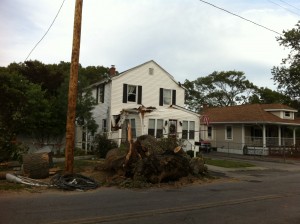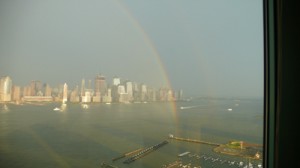A severe thunderstorm struck Rhode Island at about 6:30 this morning, knocking out trees, flooding roads and leaving more than 120,000 residents without power, more than were left without power following Superstorm Sandy. The storm brought wind gusts of 80 miles per hour, along with quarter-size hail and intense lightning strikes. I took this photograph of a nearby home that was damaged when a tree fell on it. I took this picture when it was safe to do so, in the evening, after most of the tree had been removed. By mid-afternoon, you could heat the sounds of chain saws cutting up fallen trees.
National Grid, the local utility company, reported that the storm had knocked out power to 20 major power lines that serve 12 substations, 70 main distribution lines, and hundreds of power lines and equipment on local streets and in neighborhoods. The company sent 300 line crews, 110 tree crews, and 90 wires down/”cut-and-clear” crews to work with the electric grid to turn the power back on. Then National Grid reached out to its partners in the North Atlantic Mutual Assistance Group, a group formed to enable its 33 member utility companies to assist one another in the event of an emergency. Utility crews from eight northeastern states came to Rhode Island to assist in the efforts to restore power. The mutual assistance framework now crosses national boundaries as well.
Hydro-Québec sent 60 employees, including 50 line workers as well as technical and logistics personnel, from Canada to Rhode Island to help National Grid crews. This was not the first time Hydro-Québec crews crossed the U.S. border to help the response to a severe storm. In January, the company sent 50 crews to Boston to assist after a severe blizzard. The mutual assistance framework provides a mechanism for the company requesting assistance to pay the costs of the utility companies that respond to the call for help and coordinates the logistics to avoid delays in responding.
We also saw informal mutual assistance in action as neighbors helped one another clear trees and remove debris well before responders could access the roads. I work with a virtual assistant who was accessible via cell phone. She re-scheduled my appointments for the day as it was impossible to leave my home. And I had my laptop and tablet fully charged so I was able to continue working and help others who were unable to place calls. The severe storm reminded me that it is time to update my own mutual assistance framework for my business.

